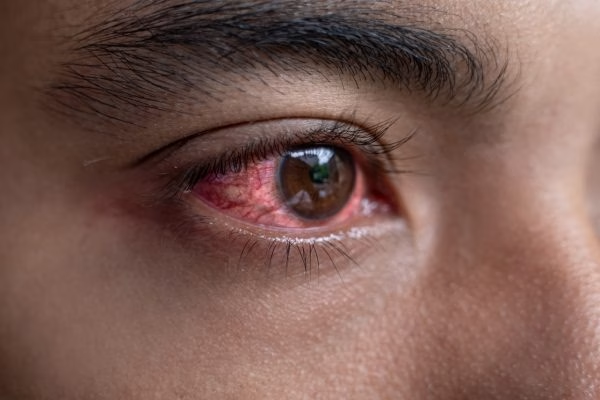
Pink eye, medically known as conjunctivitis, is a condition characterized by inflammation of the conjunctivae, the transparent membrane that lines the eyelid and covers the white part of the eyeball. When the small blood vessels in the conjunctiva become inflamed, they become more visible, resulting in the eye's characteristic pink or reddish tint.
Pink eye is one of the most common eye conditions. Although it is usually mild, depending on the cause, it can be highly contagious. Prompt diagnosis and appropriate treatment can help relieve symptoms and prevent further transmission, especially in group settings like schools and workplaces.
Types of Pink Eye
The term "pink eye" encompasses several types of conjunctivitis, each with a different cause and treatment approach.
Viral Conjunctivitis
Viral conjunctivitis is the most common form and is typically associated with respiratory infections such as the cold or flu. Adenoviruses cause this type and spread quickly through airborne droplets or hand-to-eye contact after touching contaminated surfaces.
Key Characteristics:
- Watery or clear discharge
- Redness in one or both eyes
- It often starts in one eye and spreads to the other
- Itching or irritation
Treatment:
Since viruses cause viral conjunctivitis, antibiotics are not effective. Most cases resolve on their own within 7 to 14 days. Symptom management with cold compresses, lubricating eye drops, and good hygiene is recommended.
Bacterial Conjunctivitis
Staphylococcal or streptococcal bacteria typically cause bacterial conjunctivitis. It is also highly contagious and more likely to result in thick discharge and eyelid crusting.
Key Characteristics:
- Thick, yellow, or green eye discharge
- Eyes are often stuck shut in the morning
- Usually starts in one eye but may spread
- Redness and possible swelling of eyelids
Treatment:
This form of conjunctivitis responds well to antibiotic eye drops or ointments, which can be prescribed after a medical evaluation. Treatment typically clears the infection within a few days.
Allergic Conjunctivitis
Allergic conjunctivitis is not contagious and occurs when the eyes react to allergens such as pollen, dust mites, pet dander, or mold. It often affects both eyes simultaneously.
Key Characteristics:
- Intense itching and watering
- Redness in both eyes
- Puffy eyelids
- Often seasonal, but can be year-round
Treatment:
Management includes avoiding allergen exposure, using antihistamine eye drops, oral allergy medications, and sometimes corticosteroid eye drops for severe cases.
Irritant Conjunctivitis
This type results from exposure to chemicals, smoke, or foreign bodies in the eye. It is not infectious and typically improves once the irritant is removed.
Key Characteristics:
- Burning, redness, or discomfort
- Watery eyes
- Usually resolves quickly once the irritant is eliminated
Treatment:
Rinsing the eye with sterile saline or clean water can help relieve symptoms. If irritation persists or vision is affected, medical evaluation is recommended.
Common Symptoms of Pink Eye
Regardless of the underlying cause, many forms of conjunctivitis share similar symptoms. These include:
- Red or pink discoloration of the white part of the eye
- Excessive tearing or eye discharge
- Burning or gritty sensation
- Eyelid swelling
- Light sensitivity (photophobia)
- Blurred vision (in some cases)
- Crust formation on the eyelids or lashes, especially after sleep
How Contagious Is Pink Eye?
Both viral and bacterial conjunctivitis are highly contagious. Transmission can occur through:
- Direct contact with infected eye secretions
- Sharing personal items such as towels, pillowcases, or eye makeup
- Contact with contaminated surfaces
- Poor hand hygiene
- Exposure to respiratory droplets
Because of its high transmissibility, individuals with pink eye should avoid school, work, or daycare until symptoms improve or after 24 hours of antibiotic treatment for bacterial conjunctivitis.
Diagnosing Pink Eye
A healthcare provider typically diagnoses pink eye based on a physical exam and patient history. At AFC Urgent Care Massachusetts, our providers assess:
- Onset and progression of symptoms
- Type and color of eye discharge
- Associated symptoms (such as cold or allergies)
- Any recent contact with infected individuals
In some cases, especially when the diagnosis is unclear, a swab of the eye discharge may be taken to identify the specific pathogen.
Treatment Options
Treatment varies depending on the cause:
Viral Conjunctivitis:
- Self-limiting; typically resolves within 1–2 weeks
- Supportive care: cold compresses, artificial tears, and rest
- Avoiding contact lenses during infection
Bacterial Conjunctivitis:
- Antibiotic eye drops or ointments
- Improvement is often seen within 24–48 hours of treatment
- Continue medications as prescribed even after symptoms improve
Allergic Conjunctivitis:
- Avoid known allergens
- Use antihistamine or anti-inflammatory eye drops
- May require oral allergy medications for ongoing symptom control
Irritant Conjunctivitis:
- Immediate flushing of the eyes
- Avoidance of the irritant
- Seek medical attention if symptoms persist beyond a few hours
When to Visit AFC Urgent Care Massachusetts
You should seek prompt medical care if:
- Symptoms last more than a few days without improvement
- There is moderate to severe eye pain
- Vision becomes blurred or impaired
- There is excessive light sensitivity
- Eye discharge is thick or foul-smelling
- You wear contact lenses and develop symptoms of pink eye
- A newborn shows any signs of eye redness or discharge
At AFC Urgent Care Massachusetts, we provide same-day evaluations and treatments for conjunctivitis. Our experienced providers will ensure you receive the correct diagnosis and fast relief. Find your nearest center at www.afcurgentcare.com/massachusetts.
Preventing the Spread of Pink Eye
Preventing the spread of pink eye is essential, especially in households and schools. Follow these best practices:
- Wash your hands thoroughly and frequently
- Avoid touching or rubbing your eyes
- Disinfect frequently-touched surfaces
- Don't share towels, bedding, or makeup
- Replace eye makeup and contact lens cases regularly
- Use hand sanitizer when soap and water are unavailable
These steps can significantly reduce the risk of spreading the infection to others.
Pink Eye in Children: What Parents Should Know
Children are particularly susceptible to pink eye due to close contact with others and less-developed hygiene habits. Schools and childcare facilities may require children with a pink eye to stay home until treatment has begun or symptoms have improved.
Parents should monitor symptoms closely and seek medical attention at the AFC Urgent Care Massachusetts if discharge, redness, or irritation persists. We offer pediatric-friendly urgent care with quick evaluations and treatment options, including school return notes.
While pink eye is generally not severe, recognizing the type of conjunctivitis, applying appropriate treatment, and knowing when to seek medical care is essential for effective management and recovery.
At AFC Urgent Care Massachusetts, we deliver fast, accessible, and expert care for pink eye and many other common conditions. Whether you manage symptoms at home or need prescription treatment, our walk-in clinics help you feel better quickly. Visit AFC Urgent Care Massachusetts today for prompt evaluation and treatment. No appointment is necessary.


